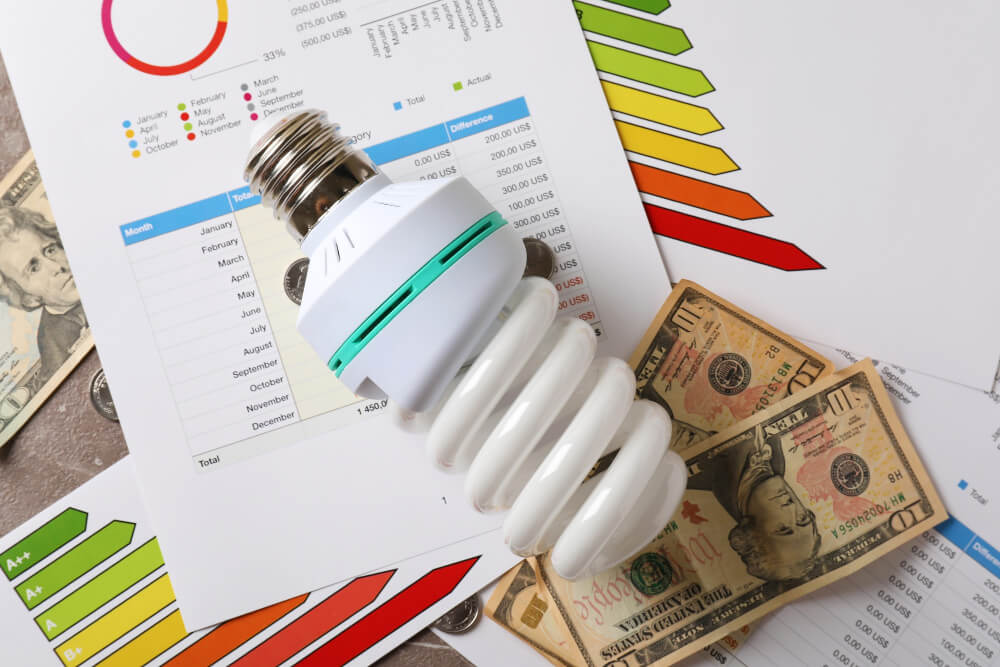For most households the electricity bill can sometimes eat up quite a chunk of the budget. This is why knowing few tricks to save money on electricity can clear up some cash each month, that can be further saved, spent to pay off remaining debt or just to have some fun.
Whole-Home Energy Efficiency
- Seal air leaks: Identify drafts around windows, doors, and vents. Use caulk for stationary cracks and weatherstripping for movable components. This prevents conditioned air from escaping, reducing heating and cooling costs.
- Add insulation: Enhance insulation in attics, walls, and floors to maintain indoor temperatures. Proper insulation reduces the workload on HVAC systems, leading to significant energy savings.
- Install a programmable thermostat: Set temperatures to adjust automatically based on your schedule. Lowering the temperature when you’re away or asleep can lead to substantial savings.
- Use ceiling fans: In summer, set fans to rotate counterclockwise to create a cooling breeze. In winter, clockwise rotation at a low speed circulates warm air.
- Close curtains and blinds: During hot days, block sunlight to keep your home cooler. In winter, open them during the day to let in warmth and close them at night to retain heat.
- Open windows at night: Allow cool air to enter during evenings, reducing the need for air conditioning. Ensure windows are secure and screens are in place to keep out pests.
- Use LED bulbs: LEDs consume up to 85% less energy than incandescent bulbs and last significantly longer, reducing both energy and replacement costs.
- Install motion sensors: Automatically turn off lights in unoccupied rooms, preventing unnecessary energy consumption.
- Unplug electronics: Devices like chargers and TVs draw power even when off, known as “phantom load.” Unplugging or using power strips can eliminate this waste.
- Use smart power strips: These detect when devices are in standby mode and cut off power, reducing phantom energy use.
Heating and Cooling
- Set thermostat wisely: Aim for 68°F in winter and 78°F in summer. Each degree adjustment can lead to noticeable savings.
- Regular HVAC maintenance: Replace filters monthly and schedule annual check-ups to ensure efficient operation.
- Seal ductwork: Leaky ducts can lose up to 30% of conditioned air. Use mastic sealant or metal tape to seal joints and connections.
- Use space heaters sparingly: They can be energy-intensive. If used, ensure they’re Energy Star-rated and only heat occupied spaces.
- Install window film: Reflective films reduce heat gain during summer, easing the load on air conditioners.
- Use portable fans: They enhance air circulation, allowing you to raise the thermostat setting without sacrificing comfort.
- Close fireplace damper: When not in use, an open damper allows warm air to escape and cold air to enter.
- Dress appropriately: Wear layers in winter and light clothing in summer to stay comfortable without over-relying on HVAC systems.
- Use electric blankets: They provide targeted warmth, allowing you to lower the thermostat at night.
- Install attic vents: Proper ventilation removes hot air in summer, reducing cooling needs.
Kitchen Efficiency
- Use microwave or toaster oven: They consume less energy than conventional ovens, especially for small meals.
- Match pot size to burner: Using a small pot on a large burner wastes energy. Ensure pot and burner sizes align.
- Keep fridge full: A full refrigerator retains cold better than an empty one. If needed, fill empty spaces with water containers.
- Set refrigerator temperature: Maintain between 37°F and 40°F for optimal efficiency and food safety.
- Defrost freezer regularly: Ice buildup forces the appliance to work harder. Regular defrosting ensures efficient operation.
- Use lids when cooking: Covering pots traps heat, cooking food faster and using less energy.
- Avoid opening oven door: Each peek drops the temperature by about 25°F, requiring more energy to regain heat.
- Let leftovers cool: Before placing them in the fridge to reduce the appliance’s workload.
- Use dishwasher efficiently: Run full loads and select energy-saving settings to minimize water and electricity use.
- Air-dry dishes: Instead of using the dishwasher’s heat-dry function, open the door post-cycle to let dishes dry naturally.
Laundry Room Tips
- Wash with cold water: Heating water accounts for a significant portion of energy used in laundry. Using cold water detergents can effectively clean clothes while saving energy.
- Run full loads: Maximize efficiency by running full loads in your washer and dryer. This reduces the number of cycles needed, saving both energy and water.
- Clean lint filter: After each dryer use, clean the lint filter to maintain airflow and efficiency. A clogged filter forces the dryer to work harder, consuming more energy.
- Air-dry clothes: Whenever possible, hang clothes to dry naturally. This eliminates the energy used by dryers and can extend the life of your garments.
- Use dryer balls: Wool or rubber dryer balls help separate clothes, improving air circulation and reducing drying time by up to 25%.
- Spin clothes well: Use the high-speed spin cycle on your washer to remove excess water, reducing the energy needed for drying.
- Dry similar fabrics together: Grouping similar fabrics ensures even drying and prevents over-drying, which wastes energy.
- Avoid over-drying: Use moisture sensors or timed drying to prevent clothes from drying longer than necessary, saving energy and protecting fabrics.
- Use high-speed spin: Selecting a high-speed spin cycle extracts more water from clothes, decreasing drying time and energy usage.
- Schedule laundry during off-peak hours: If your utility company offers time-of-use rates, doing laundry during off-peak times can lower your electricity costs.
Lighting Solutions
- Maximize natural light: Open curtains and blinds during the day to utilize sunlight, reducing the need for artificial lighting.
- Paint rooms with light colors: Light-colored walls and ceilings reflect more light, enhancing brightness and reducing the need for additional lighting.
- Use task lighting: Focus lighting on specific areas where needed, such as reading or cooking, instead of illuminating the entire room.
- Install dimmer switches: Dimmers allow you to adjust light levels according to your needs, saving energy and extending bulb life.
- Turn off lights when leaving a room: A simple habit that prevents unnecessary energy consumption.
- Use solar-powered outdoor lights: These lights charge during the day and illuminate at night without using electricity from the grid.
- Clean light fixtures: Dust and dirt can reduce light output. Regular cleaning ensures maximum brightness and efficiency.
- Replace outdated fixtures: Modern lighting fixtures are designed for energy efficiency and can accommodate LED bulbs.
- Use LED holiday lights: LEDs consume less power and last longer, making them ideal for festive decorations.
- Install skylights: Skylights bring in natural light, reducing the need for artificial lighting during the day.
Electronics and Appliances
- Enable sleep mode: Set computers and monitors to enter sleep mode after periods of inactivity, reducing energy consumption.
- Turn off gaming consoles: When not in use, completely power down gaming systems to prevent energy drain.
- Use energy-efficient appliances: Look for ENERGY STAR® certified appliances, which meet energy efficiency guidelines set by the U.S. Environmental Protection Agency.
- Charge devices during off-peak hours: If your utility offers time-of-use rates, charging electronics during off-peak times can save money.
- Limit use of space heaters: These can be energy-intensive. Use them only when necessary and in small, enclosed spaces.
- Use laptops instead of desktops: Laptops generally consume less energy than desktop computers.
- Avoid screen savers: They can prevent computers from entering energy-saving sleep modes.
- Unplug chargers: Chargers draw power even when not connected to devices. Unplug them when not in use.
- Use smart plugs: These allow you to control appliances remotely and set schedules, reducing unnecessary energy use.
- Limit use of high-energy devices: Devices like hairdryers and curling irons consume significant energy. Use them efficiently and sparingly.
Water Heating Efficiency
- Lower water heater temperature: Set your water heater to 120°F instead of the default 140°F. This reduces energy use and prevents scalding.
- Insulate your water heater: Use a water heater blanket to reduce standby heat loss, especially if your heater is in a garage or basement.
- Insulate hot water pipes: Pipe insulation helps retain heat, reducing the need for reheating water and speeding up hot water delivery.
- Fix leaky faucets: A hot water leak wastes both water and the energy used to heat it. Repair leaks promptly.
- Install low-flow fixtures: Low-flow showerheads and faucets reduce water and energy use without sacrificing performance.
- Take shorter showers: Reducing shower time by just a few minutes can save gallons of hot water daily.
- Use cold water for shaving/washing hands: For tasks that don’t require hot water, cold is fine and saves energy.
- Turn off water when not in use: While brushing teeth or washing dishes, turn off the tap to reduce unnecessary hot water use.
- Use a timer for hot water recirculating pumps: Only operate the pump when hot water is needed to avoid continuous energy use.
- Consider a tankless water heater: These heat water on demand, eliminating standby losses from storing hot water.
Smart Home and Automation
- Install a home energy monitor: Track your energy use in real-time and identify high-consumption devices or habits.
- Automate lights: Use timers or smart systems to turn lights on/off based on your schedule.
- Automate blinds and shades: Smart window coverings can optimize natural light and temperature control.
- Use occupancy sensors: These turn off lights and electronics when rooms are unoccupied.
- Install smart thermostats: These learn your habits and adjust heating/cooling efficiently.
- Integrate with voice assistants: Use voice commands to control energy use—turn off lights, set thermostat, etc.
- Schedule appliances: Run dishwashers or washing machines during off-peak hours using smart plugs or appliances.
- Monitor and control remotely: Use apps to turn off devices you forgot when you left the house.
- Set energy goals: Use smart systems to track and achieve personal electricity reduction goals.
- Get usage reports: Analyze monthly usage and compare trends to spot savings opportunities.
DIY Projects and Upgrades
- Install weatherstripping: Seal doors and windows to prevent drafts and reduce heating/cooling needs.
- Replace old windows: Double or triple-pane windows offer better insulation and energy efficiency.
- Switch to induction cooktops: More efficient than electric or gas, they heat faster and use less energy.
- Upgrade attic insulation: Ensures minimal heat loss during winter and keeps heat out in summer.
- Install radiant barriers: Reflects radiant heat away from your home in hot climates.
- Use reflective roof coatings: These reduce cooling needs by reflecting more sunlight.
- Install solar attic fans: Powered by the sun, they reduce attic heat without consuming electricity.
- Build a clothesline: Use solar power (sunlight) to dry clothes for free.
- Add storm doors/windows: Improve insulation and block drafts from old or single-pane windows.
- Replace old insulation: Upgrade deteriorating insulation to modern standards for better thermal efficiency.
Sustainable Lifestyle Choices
- Switch to green energy providers: Many utilities offer renewable electricity plans—solar, wind, or hydro-powered.
- Install solar panels: Generate your own electricity and potentially sell excess back to the grid.
- Participate in demand response programs: Get paid or receive discounts to reduce usage during peak times.
- Downsize your home: Smaller homes use less electricity for lighting, heating, and cooling.
- Use manual tools when possible: Hand-mixers, push mowers, and manual can openers use zero electricity.
- Limit energy-intensive hobbies: Be mindful of high-electricity activities like crypto-mining or home brewing.
- Practice off-grid living part-time: Use camping-style gear and solar lighting for an evening or weekend unplugged.
- Avoid unnecessary appliance upgrades: Keep appliances until they truly need replacing to avoid manufacturing energy waste.
- Compost food waste: Reduces refrigerator space for waste and cuts energy needed for trash management.
- Educate others: Share your energy-saving tips with family and friends to multiply the impact.


